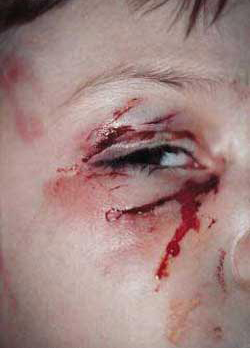Facial Dog Bites in Children
I have not been shy about my feelings for dogs with my friend’s and family over the years. I love all animals, I just don’t want them butt-sliding on my carpet, shedding on my couch, or biting my childrens’ faces off. Harsh, maybe, but it is worth considering a doctor’s perspective on this last point before calling PETA to picket my office. Over the past few years, without fail, week in and week out, I see and treat kiddos whose little cheeks, noses, eyelids and foreheads have been permanently scarred or worse because mom and dad thought Fido was completely harmless. I’m here to tell you that he is not, no matter how well trained, how much you overpaid for him, or what the local dog whisperer tells you.
Over 4 million dog bites are thought to occur annually in the US and over 500,000 require medical care in the ER. Small children are particularly at risk for facial dog bites as they are down at the dogs level, and dogs seem programmed to go for the face when provoked. I’m willing to wager that most of you know 1 or more people with a scar on their face from a dog bite as a child. I am usually called when these bites involve the eyelids and often cut through the tear drain system, or rarely, completely tear off the eyelid. Most can be fixed satisfactorily, but nearly all still result in a scar. And dog bites are at high risk of becoming infected, so using antibiotics for 3-7 days is recommended (no, your dog’s mouth is not sterile as some think, stop letting them lick your face or your ice cream cone *shudder*). Clearly, dogs pose a risk to their owners and to children, no matter who causes them to lash out. There are, however, many things you can do to prevent these unfortunate injuries from taking place.
A dog’s propensity to bite is affected by many factors, including heredity, sex, early nuturing, interactions and training, overall health and reproductive status. Males are over 6 times more likely to bite than females. Neutered dogs are 2-1/2 times less likely to bite and unchained dogs are almost 3 times less likely. Sexually intact males and females are generally more aggressive, especially when tending to their young. Large breed dogs will obviously inflict more damage when biting, which accounts for their disproportionate number of reported dog bites. Below are the most common breeds causing serious or fatal bites according to a popular law website:
Common Dog Bites causing injury or fatality:
- Labrador Retriever
- Bulldogs
- Akita
- Bullmastiff
- Mastiff
- Boxer
- Collie
- Cocker Spaniel
- Sheepdog
- Ridgeback
- Australian Shepherd
- Chesapeake Bay Retriever
- Coonhound
Notice that the Labrador Retriever, considered a great family/kids dog is top of the list. This is mostly due to its being so common, but also because people underestimate its temperament. Certain breeds, such as bulldogs, are bred for aggression and will bite with little or no provocation and often without showing any behavioral warning signs. In a 2001 study, children aged 0-14 comprised 42% of all people presenting at the ER for dog bite treatment. In a separate study where greater than 90% of dog bites were from animals owned by the family, 63% of those dogs bit again when kept by the family. I have personally stitched up the face of a child twice in one year after dog bites from the same dog. The following are ways to prevent dog bites from ever happening:
1. Properly train and socialize your own dog: Never tolerate aggressive behavior by saying, “that’s just how he/she is” or blame it on the breed.
2. Control the number of aggressive dogs: Neuter male dogs to reduce aggressive tendencies, limit reproduction where dogs have little chance of proper socialization, confront aggressive behavior, and limit the breeding of pit bulls. (Personal opinion: these dogs are a menace and bringing one into your home or allowing your kids near one is a form of child endangerment).
3. Obey leash laws: It doesn’t matter how docile you think your dog is, you don’t know how he/she will behave when confronted by a stranger. As someone who has been bitten or just jumped all over by strange dogs while their owners stand by, I can attest that this isn’t pleasant. If you truly love your pet, don’t put them in a situation where they could hurt someone else, especially children, or you’ll be giving them a one-way ticket to the gas chamber. Don’t let your children approach strange dogs or hug or tease any dog that is in the least bit aggressive. An unknown dog older than four months should not be placed in a household with young children unless it has been evaluated by an animal behaviorist or by a veterinarian.
4. Know when dogs are more likely to be aggressive: dogs that have recently delivered puppies or are eating or sleeping tend to be in a foul mood when messed with. Teach your kids to treat dogs kindly and never tease them or take away food or bones.
5. Use proper barriers: Enclosures, fences and sometimes muzzles should be used to keep dogs away from potential problems.
I’ll admit, dogs can be loveable, like when they are biting criminals, carrying whiskey to lost alpine skiers, or playing poker and smoking cigars. Let’s just use some common sense around them so our kids will also find them loveable and avoid ever having to meet me in the ER..


